The Main tab of the AM Asset Maintenance form contains the following fields and options:
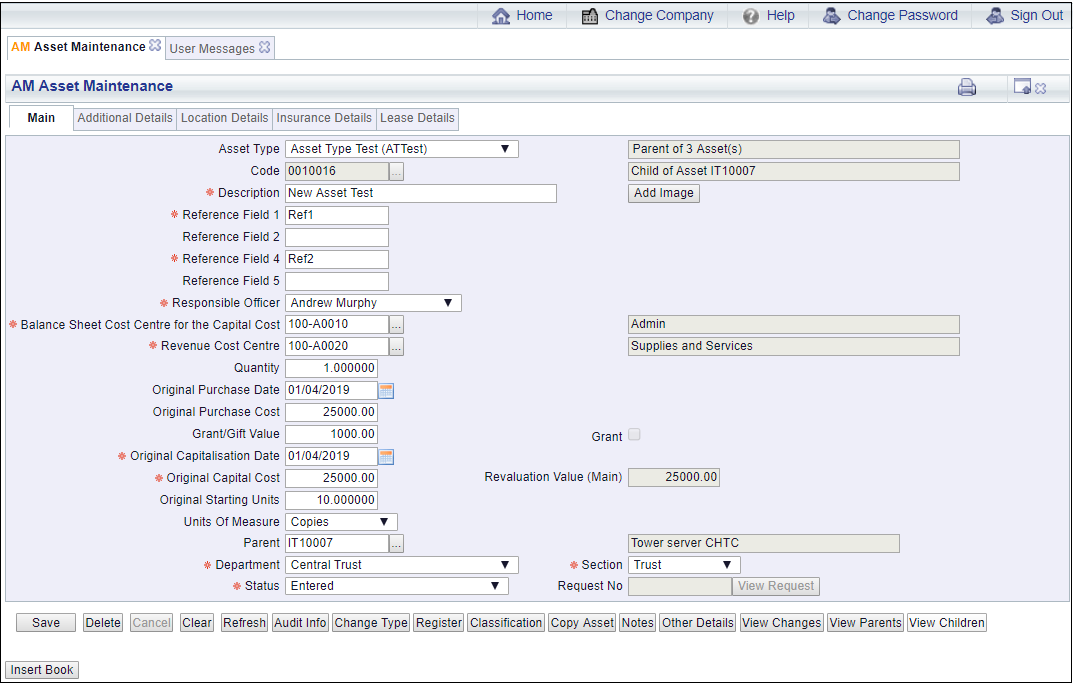
The fields and buttons available on the Main tab on the AM Asset Maintenance form will depend on the status of the Asset that is displayed in the Status field. These statuses are further detailed in the Asset Statuses section.
Please note: There may be fields displayed between the Description field and the Responsible Officer field on the form:

These are User defined Reference fields that are defined by the Asset Type selected in the Asset Type field, including the number of fields displayed (a maximum of 5), the name of the each field and whether they are mandatory or discretionary fields. The details in these fields can be amended where the status of the Asset is set to ![]() or
or ![]() . It can also be changed when the status is
. It can also be changed when the status is ![]() via the
via the ![]() button, which is further detailed below. Asset Types are further detailed in the Asset Types section.
button, which is further detailed below. Asset Types are further detailed in the Asset Types section.
The other fields and options are further detailed below (mandatory fields are notated with a red asterisk *):
The Asset Type will also define certain default fields when inserting an Asset Book via the ![]() button, which is further detailed below.
button, which is further detailed below.
The Asset Type in this field cannot be changed directly on this field but can be changed via the ![]() button, as detailed bellow, where it is displayed. Asset Types are further detailed in the Asset Types section.
button, as detailed bellow, where it is displayed. Asset Types are further detailed in the Asset Types section.
 : Clicking on this button will allow you to add an image of the Asset from your network. An Upload Image pop-up box will open:
: Clicking on this button will allow you to add an image of the Asset from your network. An Upload Image pop-up box will open: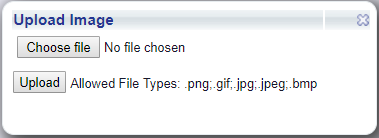
Click on the  button and select the required image from your network - the name of the mage will then be added next to this button.
button and select the required image from your network - the name of the mage will then be added next to this button.
Then click on the  button - the types of files that can be uploaded are listed next to this button.
button - the types of files that can be uploaded are listed next to this button.
It can only be changed when the status is at ![]() .
.  or
or ![]() .
.
The required Cost Centre code can be added into the field or alternatively it can be searched for and selected by clicking on the Find Cost Centre button located to the right of this field,  . This will open the AM Find Balance Sheet Cost Centres for the Capital Cost form where the required Cost Centre can be searched for and once selected will be added to this field. This form is further detailed in the Find Balance Sheet Cost Centre section.
. This will open the AM Find Balance Sheet Cost Centres for the Capital Cost form where the required Cost Centre can be searched for and once selected will be added to this field. This form is further detailed in the Find Balance Sheet Cost Centre section.
It can be changed where the status is at ![]() ,
, ![]() or
or ![]() . It can also be changed when the status is
. It can also be changed when the status is ![]() via the
via the ![]() button, which is further detailed below.
button, which is further detailed below.
The required Cost Centre code can added into the field or alternatively it can be searched for and selected by clicking on the Find Cost Centre button located to the right of this field, ![]() . This will open the AM Find Revenue Cost Centres form where the required Cost Centre can be searched for and once selected will be added to this field. This form is further detailed in the Find Revenue Cost Centre section.
. This will open the AM Find Revenue Cost Centres form where the required Cost Centre can be searched for and once selected will be added to this field. This form is further detailed in the Find Revenue Cost Centre section.
Where it includes 1 it will be recorded as a single Asset.
The amount in this field can only be changed when the status is at ![]() ,
, ![]() or
or ![]() .
.
This field can only be changed when the status is at ![]() ,
, ![]() or
or ![]() .
.
This field can only be changed when the status is at ![]() ,
, ![]() or
or ![]() .
.
This field can only be changed when the status is at ![]() .
. ![]() or
or ![]() .
.
It can be changed when the status is at ![]() ,
,![]() or
or ![]() . It can also be changed when the status is
. It can also be changed when the status is ![]() via the
via the ![]() button, which is further detailed below.
button, which is further detailed below.
Once an Asset Book has been inserted, the Depreciation Start Date on the Book will not be changed by changing the Original Capitalisation Date.
It can only be changed when the status is at ![]() ,
, ![]() or
or ![]() .
.
 button, as detailed below. The Revaluation Value (Main) field will display either the amount in the Original Capital Cost field as detailed immediately above, or an amended amount following a Revaluation transaction. Revaluation transactions are further detailed in the Revaluation section.
button, as detailed below. The Revaluation Value (Main) field will display either the amount in the Original Capital Cost field as detailed immediately above, or an amended amount following a Revaluation transaction. Revaluation transactions are further detailed in the Revaluation section.Where the Revaluation Value (Main) field is set to 0.00 it will be populated with the amount in the Original Capital Cost field, detailed immediately above, when an Asset Book is inserted on the Asset via the ![]() button detailed below.
button detailed below.
This field can only be changed when the status is at ![]() ,
, ![]() or
or ![]() .
.
Once an Asset Book has been inserted, the Starting Units field on the Book will not be changed by changing the Original Starting Units.
This field can only be changed when the status is at ![]() ,
, ![]() or
or ![]() by selecting a different option from the drop-down list, or if the field is blank by selecting the relevant item from the drop-down list.
by selecting a different option from the drop-down list, or if the field is blank by selecting the relevant item from the drop-down list.
This field can be changed when the status is at ![]() ,
, ![]() or
or ![]() . It can also be changed when the status is
. It can also be changed when the status is ![]() via the
via the ![]() button, which is further detailed below.
button, which is further detailed below.
The required Asset Code can be added or alternatively it can be searched for and selected by clicking on the Find Asset button located to the right of this field,  . This will open the AM Find Asset Parents form where the required Asset can be searched for and once selected will be added to this field. This form is further detailed in the Find Asset Parent section.
. This will open the AM Find Asset Parents form where the required Asset can be searched for and once selected will be added to this field. This form is further detailed in the Find Asset Parent section.
In these cases the option can be changed by selecting a different Section from the drop-down list, which will be dependant on the Department added to the Department field, detailed immediately above.
The buttons available at the bottom of the form will also be dependant on the status of the Asset. These are are follows:
 : This button will only be displayed where the Asset has a status of
: This button will only be displayed where the Asset has a status of Postings for the Asset cannot be made to the General Ledger until the Asset is Registered. Before the Asset can be registered, an Asset Book must be inserted into the Asset - this is done via the  button, as detailed below - and the Asset must also have a Classification Code, which is added via the
button, as detailed below - and the Asset must also have a Classification Code, which is added via the ![]() button detailed below.
button detailed below.
Clicking on the ![]() button will change the Status field from
button will change the Status field from ![]() to
to ![]() .
.
 : This button will only be available where the status of the Asset is at
: This button will only be available where the status of the Asset is at Clicking on this button will change the status of the Asset to ![]() and you will not be able to make any further changes the fields on this tab as well as the other tabs.
and you will not be able to make any further changes the fields on this tab as well as the other tabs.
Once an Acquisition Transaction has been created for the Asset, the Status will change to ![]() .
.
Please note: ensure that all the details added to this tab, as well as the other tabs on the AM Asset Maintenance form, are correct before making the Asset a Live Asset. Only certain details can be amended via the ![]() button, as detailed above.
button, as detailed above.
Clicking on the ![]() button and then the
button and then the ![]() button will save the changes made to any of the tabs on the AM Asset Maintenance form. The Status will also revert to
button will save the changes made to any of the tabs on the AM Asset Maintenance form. The Status will also revert to ![]() .
.
Adding a Classification is further detailed in the Adding Classifications section and viewing and amending the Classification is further detailed in the Amending Classifications section.
Clicking on this button where the Status of the Asset is at ![]() will open the AM Classification Code Maintenance form allowing you to view and amend the Classification of the Asset. This is further detailed in the Amending Classifications section.
will open the AM Classification Code Maintenance form allowing you to view and amend the Classification of the Asset. This is further detailed in the Amending Classifications section.
Clicking on this button when the Status of the Asset is at any other status will open the AM Classification Code Maintenance (Readonly) form where you can view the Classification of the Asset but can make no changes. This form is further detailed in the Read Only Classifications section.
 : Clicking on this button will allow you to create a new Asset with the details of this Asset. The AM Asset Copy form will open with these details:
: Clicking on this button will allow you to create a new Asset with the details of this Asset. The AM Asset Copy form will open with these details: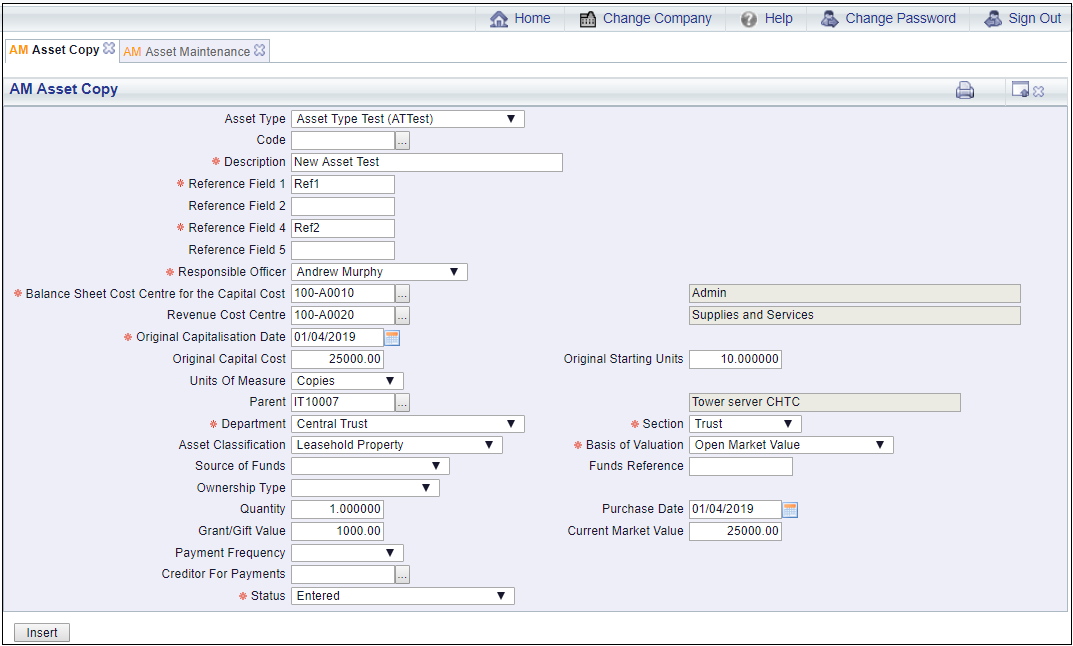
Add a code for the new Asset in the Code field, amend the details in the fields as required and click on the ![]() button to create the new Asset.
button to create the new Asset.
 . Notes are further detailed in the Notes section.
. Notes are further detailed in the Notes section. : Where this button is displayed clicking on it will open the AM Disposal form allowing you to create a Disposal transaction in order to dispose of the Asset.
: Where this button is displayed clicking on it will open the AM Disposal form allowing you to create a Disposal transaction in order to dispose of the Asset.Where a Disposal transaction has already been created for the Asset but has not yet been competed, i.e. the Status of the Asset is set at ![]() , the AM Disposal form will be loaded with this transaction. The details of the transaction can be amended, if required, and/or completed. This is further detailed in the Amending Disposal Transactions section.
, the AM Disposal form will be loaded with this transaction. The details of the transaction can be amended, if required, and/or completed. This is further detailed in the Amending Disposal Transactions section.
Where a Disposal transaction has not yet been created, the AM Disposal form will open allowing you to create and complete a new transaction. This is further detailed in the Creating Disposal Transactions section.
 : Where this button is displayed clicking on it will open the AM Revaluation form allowing you to revalue the Asset.
: Where this button is displayed clicking on it will open the AM Revaluation form allowing you to revalue the Asset.Where a Revaluation transaction has already been created for the Asset but has not yet been completed, i.e. the Status of the Asset is set at ![]() , the AM Revaluation form will be loaded with this transaction. The details of the transaction can be amended, if required, and/or completed. This is further detailed in the Amending Revaluation Transactions section.
, the AM Revaluation form will be loaded with this transaction. The details of the transaction can be amended, if required, and/or completed. This is further detailed in the Amending Revaluation Transactions section.
Where a Revaluation transaction has not yet been created, the AM Revaluation form will open allowing you to create and complete a new transaction. This is further detailed in the Creating Revaluation Transactions section.
 : Where this button is displayed clicking on it will open the AM Relife form allowing you to change the Estimated Life or Residual Value of the Asset Book on the Asset.
: Where this button is displayed clicking on it will open the AM Relife form allowing you to change the Estimated Life or Residual Value of the Asset Book on the Asset.Where a Relife transaction has already been created for the Asset but has not yet been completed, i.e. the Status of the Asset is set at ![]() , the AM Relief form will be loaded with this transaction. The details of the transaction can be amended, if required, and/or completed. This is further detailed in the Amending Relife Transactions section.
, the AM Relief form will be loaded with this transaction. The details of the transaction can be amended, if required, and/or completed. This is further detailed in the Amending Relife Transactions section.
Where a Relife transaction has not yet been created, the AM Relife form will open allowing you to create and complete a new transaction. This is further detailed in the Creating Relife Transactions section.
Where a Transfer transaction has already been created for the Asset but has not yet been completed, i.e. the Status of the Asset is set at ![]() , the AM Transfer form will be loaded with this transaction. The details of the transaction can be amended, if required, and/or completed. This is further detailed in the Amending Transfer Transactions section.
, the AM Transfer form will be loaded with this transaction. The details of the transaction can be amended, if required, and/or completed. This is further detailed in the Amending Transfer Transactions section.
Where a Transfer transaction has not yet been created, the AM Transfer form will open allowing you to create and complete a new transaction. This is further detailed in the Creating Transfer Transactions section.
Where a Split transaction has already been created for the Asset but has not yet been completed, i.e. the Status of the Asset is set at ![]() , the AM Split form will be loaded with this transaction. The details of the transaction can be amended, if required, and/or completed. This is further detailed in the Amending Split Transactions section.
, the AM Split form will be loaded with this transaction. The details of the transaction can be amended, if required, and/or completed. This is further detailed in the Amending Split Transactions section.
Where a Split transaction has not yet been created, the AM Split form will open allowing you to create and complete a new transaction. This is further detailed in the Creating Split Transactions section.
Where a Depreciation transaction has already been created for the Asset but has not yet been completed, i.e. the Status of the Asset is set at ![]() , the AM Depreciate form will be loaded with this transaction. The details of the transaction can be amended, if required, and/or completed. This is further detailed in the Amending Depreciation Transactions section.
, the AM Depreciate form will be loaded with this transaction. The details of the transaction can be amended, if required, and/or completed. This is further detailed in the Amending Depreciation Transactions section.
Where a Depreciation transaction has not yet been created, the AM Depreciation form will open allowing you to create and complete a new transaction. This is further detailed in the Creating Depreciation Transactions section.
 : Where this button is available clicking on it open the AM Asset Transaction History form allowing you to view the transaction history of the Asset. This form is further detailed in the Transaction History section.
: Where this button is available clicking on it open the AM Asset Transaction History form allowing you to view the transaction history of the Asset. This form is further detailed in the Transaction History section. : Clicking on this button will open the AM Asset Other Details screen and will display the full financial information from the Asset Book added to the Asset. This form is further detailed in the Other Details section.
: Clicking on this button will open the AM Asset Other Details screen and will display the full financial information from the Asset Book added to the Asset. This form is further detailed in the Other Details section.Please note: An Asset Book will need to be inserted into the Asset via the ![]() button, as detailed below, before these details can be displayed on this form.
button, as detailed below, before these details can be displayed on this form.
Please note: The only changes that can be viewed are those that have been done via the![]() button when the Asset has a Status set to
button when the Asset has a Status set to ![]() , which is further detailed above.
, which is further detailed above.
 : This button will only be displayed where the Asset is a Child of another Asset. The Parent Asset will be displayed in the Parent field detailed above as well as in a field at the top-right of the form:
: This button will only be displayed where the Asset is a Child of another Asset. The Parent Asset will be displayed in the Parent field detailed above as well as in a field at the top-right of the form:
Clicking on this button will open the AM Asset's Parents form, allowing you to view the Asset's Parents. This form is further detailed in the Assets Parents section.
 : This button will only be displayed where the Asset is a Parent of one or more Assets. The number of Children that the Asset has will be displayed in a field at the top-right the form:
: This button will only be displayed where the Asset is a Parent of one or more Assets. The number of Children that the Asset has will be displayed in a field at the top-right the form:
Please note: the number of Children in this field will not include any Child Assets that have been Disposed or have been Cancelled.
Clicking on this button will open the AM Asset's Children form, allowing you to view these Child Assets. This form is further detailed in the Assets Children section.
Please note: A Main Asset Book will be required to be added. Further Asset Books can be added but only if this had been configured with agreement from your organisation.
Once an Asset Book has been inserted, it will be added to a Grid underneath the ![]() button:
button:
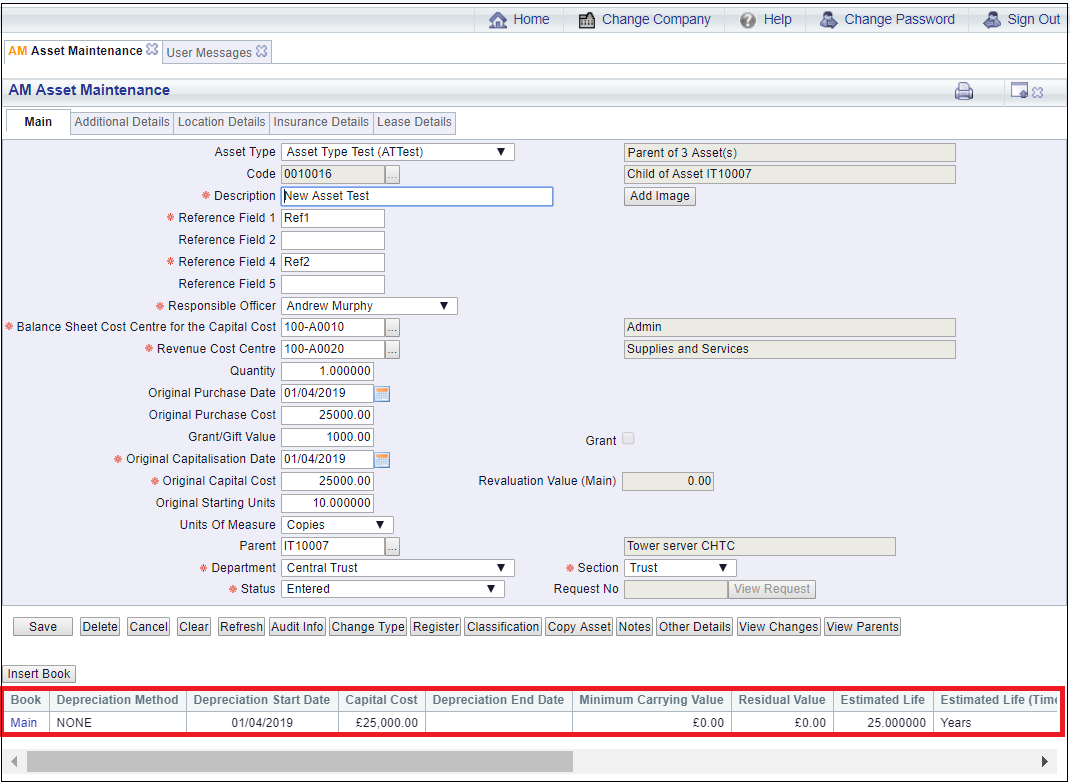
Further Asset Books can be inserted but only if FinancialsLIVE has been configured to allow more than one Asset Book to be inserted into an Asset.
Where an Asset Book has been inserted it can be amended or removed where the status of the Asset is either at ![]() or
or ![]() .
.
It can be amended by clicking on the link on the Book column of the Grid:
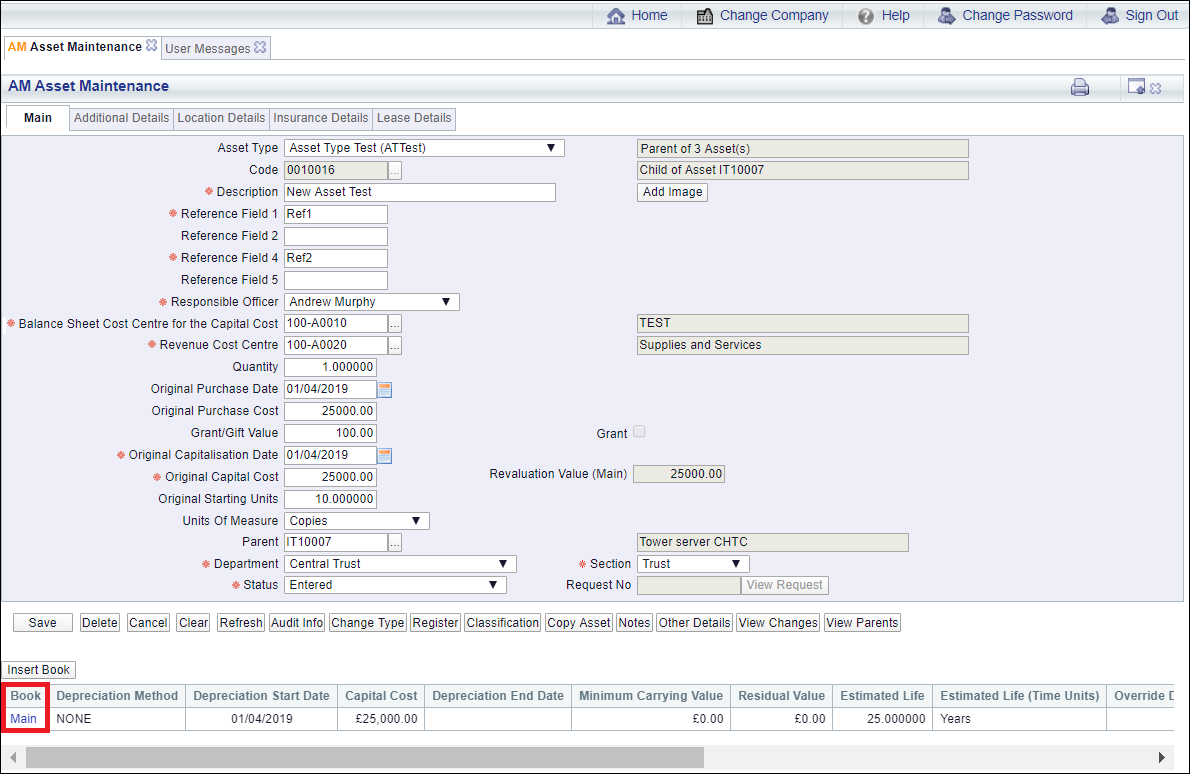
The AM Asset Maintenance (Edit Book) form will be displayed, which is further detailed in the Amending Books section.
An Asset Book can be removed from the Asset by clicking on the Delete link on the relevant Line on the Asset Book Grid:

This will open the AM Asset Maintenance (Delete Books) screen:

The following buttons are available on this form :